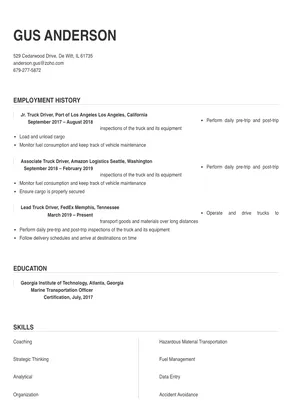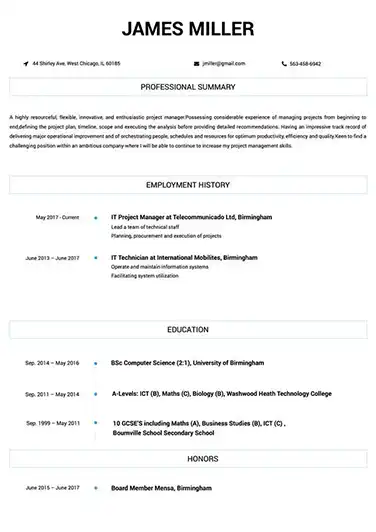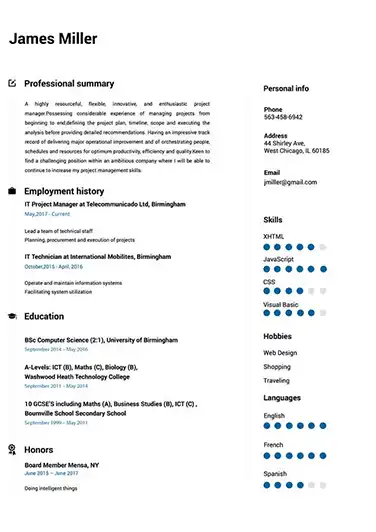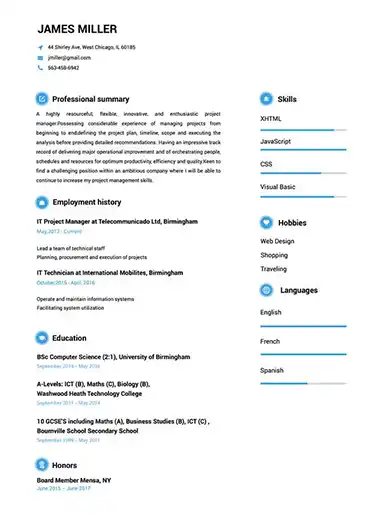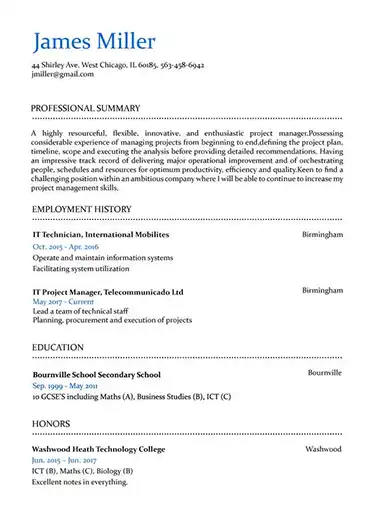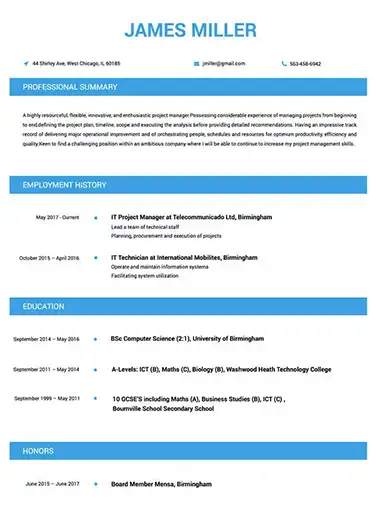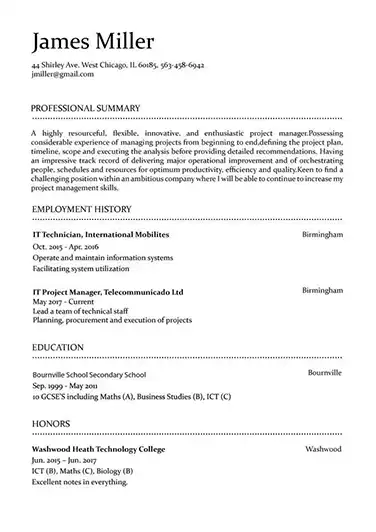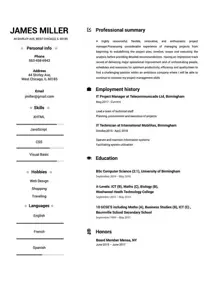 Use This Template
Use This Template
Build your resume in 15 minutes
Create an awesome resume that meets the expectations of potential employers with our selection of professional, field-tested resume templates.
truck driver: Resume Samples & Writing Guide
anderson.gus@zoho.com
679-277-5872
Employment history
- Operate and drive trucks to transport goods and materials over long distances
- Perform daily pre-trip and post-trip inspections of the truck and its equipment
- Follow delivery schedules and arrive at destinations on time
- Perform daily pre-trip and post-trip inspections of the truck and its equipment
- Monitor fuel consumption and keep track of vehicle maintenance
- Ensure cargo is properly secured
- Perform daily pre-trip and post-trip inspections of the truck and its equipment
- Load and unload cargo
- Monitor fuel consumption and keep track of vehicle maintenance
Education
Skills
Do you already have a resume? Use our PDF converter and edit your resume.
stanley_wood@outlook.com
720-998-1222
Professional Summary
Employment history
- Monitor fuel consumption and keep track of vehicle maintenance
- Operate and drive trucks to transport goods and materials over long distances
- Maintain a clean and organized truck cab
- Communicate with dispatchers, other drivers, and customers in a professional manner
- Operate and drive trucks to transport goods and materials over long distances
- Monitor road conditions and adjust driving accordingly
- Ensure cargo is properly secured
- Follow delivery schedules and arrive at destinations on time
- Adhere to company policies and procedures
Education
Skills
taylorian@outlook.com
911-768-7149
Employment history
- Load and unload cargo
- Perform daily pre-trip and post-trip inspections of the truck and its equipment
- Stay up-to-date with applicable laws and regulations
- Follow delivery schedules and arrive at destinations on time
- Communicate with dispatchers, other drivers, and customers in a professional manner
- Provide excellent customer service
- Stay up-to-date with applicable laws and regulations
- Provide excellent customer service
- Follow delivery schedules and arrive at destinations on time
Education
Skills
parker.francis@inbox.com
790-171-6471
Employment history
- Follow delivery schedules and arrive at destinations on time
- Monitor road conditions and adjust driving accordingly
- Communicate with dispatchers, other drivers, and customers in a professional manner
- Maintain accurate logs of driving activities
- Follow delivery schedules and arrive at destinations on time
- Adhere to company policies and procedures
- Report any mechanical issues to the appropriate personnel
- Monitor road conditions and adjust driving accordingly
- Ensure cargo is properly secured
Education
Skills
daleturner5@protonmail.com
891-305-9658
Professional Summary
Employment history
- Stay up-to-date with applicable laws and regulations
- Provide excellent customer service
- Report any mechanical issues to the appropriate personnel
- Monitor fuel consumption and keep track of vehicle maintenance
- Communicate with dispatchers, other drivers, and customers in a professional manner
- Follow applicable laws and safety regulations while driving
- Monitor fuel consumption and keep track of vehicle maintenance
- Report any mechanical issues to the appropriate personnel
- Maintain accurate logs of driving activities
Education
Skills
Not in love with this template? Browse our full library of resume templates
Truck drivers are an integral part of how the global economy functions. Without qualified people to drive huge amounts of cargo long distances, there’d be no way for stores and companies all over the world to meet the needs of their customers. If you love driving and you like spending time on your own, becoming a truck driver could be the perfect career move for you.
Throughout the following article, we’ll be giving you advice on how best to create a truck driver resume that’ll catch the eye of any recruiter and make you seem like a great candidate for the job. If you’ve always wanted to drive a truck professionally but don’t know where to start, this guide is the perfect jumping-off point for you.
Multiple Template Examples
How to Write a Truck Driver Resume That Will Get You the Job
How to Format It
The best choice of format for a truck driver’s resume is the classic chronological layout. This will help the recruiter see how your career has progressed so far, and even if you don’t have much experience you’ll be able to highlight your education and additional achievements early-on to grab their attention.
If you already have a lot of experience working as a truck driver and you’re simply applying to a new position, however - you might be better off going for the reverse chronological format. By listing your most recent jobs first, you’ll be showing whoever’s reading your resume that you’re not out of practice at all, and that you’ll be able to take on the needs of their job without much of an adjustment period.
What Recruiters Will Look For
Recruiters who are poring over a pile of truck driver resumes will have their eyes peeled for a few important traits. Because being a truck driver is potentially dangerous on account of the heavy cargo and high degree of skill required to transport it around, certain skills like critical thinking and the ability to stay calm under pressure will be particularly appreciated.
Here are some of the main things recruiters will be looking out for as they go through your truck driver’s resume:
1. The Ability to Deliver on Schedule
The entire job rests on the driver’s ability to get his cargo to where it needs to be, on schedule. Being even an hour late could potentially have serious repercussions for the rest of the operation, so whoever’s hiring for the job will be particularly keen on ensuring that their chosen candidate can stick to a schedule day in, day out.
2. Problem Solving Skills
You’ll have to solve problems continuously throughout the course of your work as a truck driver. In addition to the act of driving itself, which requires solving problems on the go, you’ll also need to coordinate several different elements in order to be effective in the work you do. For example, you’ll need to be able to follow a route, but you should also have the ability to adapt if unforeseen circumstances, like a car crash, force a change in the predetermined plan.
Another way you can use your problem-solving skills as a truck driver is to point out routing errors that could cost your company thousands upon thousands of dollars if they’re not fixed. Your work as a truck driver is going to be full of opportunities to impress your higher-ups, so problem-solving is one of the main things recruiters will be hoping to see on the resumes of prospective candidates.
3. The Ability to Reliably Satisfy Customers
You could be the most technically skilled driver on the planet, but if you’re not able to meet the customer’s needs on a regular basis, your employers won’t be too impressed. It’s all about ensuring that the people you’re delivering for have their needs met. That could be as simple as sticking to or exceeding the prescribed schedule, or it could be a bit more complicated in cases where there’s a discrepancy between what’s in the back of your truck and what the customer was expecting.
You’ll need to resolve any issues that arise with the customers you’re serving effectively, efficiently, and politely. If you’ve been able to maintain stellar customer satisfaction figures throughout your work history, your recruiter’s eyes will light up when they get to your resume, which is exactly the effect you should be aiming for.
Which Skills to Mention and How to Do It Correctly
The skills section is perhaps the single most important aspect of your resume after experience. For truck drivers there are a lot more technical skills to take into account than with most other jobs, but that doesn’t mean you can neglect the soft skills though.
After all, there’s a lot more to being a trucker than simply being able to keep driving for extended periods of time. Generally speaking, the distinction between hard skills and soft skills, which is so prevalent in more standard office-type jobs, holds true for truck driving as well. Here’s a thorough list of the skills to focus on in your resume:
Hard Skills
The hard skills you’ll use as a truck driver usually relate to technical issues that you’ll need to handle throughout the course of your day-to-day work. Here are some of the most important hard skills to include on your resume to impress the recruiter and get yourself a call back:
- OTR Driving
- Load Bar Operation
- Vehicle Inspection & Maintenance
- Excellent technical driving skills, ideally demonstrated by a spotless driving record
- Loading & Unloading Freight
- Truck Tarping
- Load Bar Operation
Soft Skills
In comparison to the hard skills — which focus on selling yourself as a technically able truck operator — your soft skills will be a way to present yourself as a competent person to work with. In addition to being able to handle the demands of the job, it’s a good idea to come across as a self-sufficient individual, capable of operating with minimal guidance from above. See below for the ideal soft skills to mention in addition to the hard skills above:
- Honesty
- The ability to own up to mistakes and take responsibility for them
- Dependability
- Excellent work ethic
- Great critical judgement
- Good level of physical fitness
- Familiarity with effective communication
How to Highlight Your Achievements
You might think that achievements in arenas other than driving trucks won’t play a big part in your candidacy. That would be a mistake, however, since including a few achievements you’ve managed to pull off over the years is actually a great way to round off an application.
It’s not a great idea to be too fussy about which achievements you should include. Similarly, including achievements isn’t purely a numbers game, where the more bullet points on your list, the better you perform. As it happens, it can actually be more impressive to stick to a lower number of achievements, but to ensure you’re writing about them in the right way.
A good rule of thumb to bear in mind as you go about creating this part of your resume is that for every achievement you mention, you should include a few words that highlight why it’s relevant to being a truck driver. For example, if you won an essay-writing award in school, that would be an excellent opportunity to talk about your critical thinking skills. In a similar vein, if you’ve won any kind of sporting or athletic competition, that’s a natural lead-in to talking about your physical fitness.
Keep the list of skills above in mind when you’re selecting which achievements to include in your resume, and try to draw connections between the two when possible. This will result in a much more impressive overall package, and should help you to stand out from the crowd when it comes time for the recruiter to decide who to invite for an interview.
Why It’s Important to Include Additional Training and Certifications in a Truck Driver’s Resume
Driving a truck is one of the prime examples of jobs, for which additional training and certifications can be a huge help. Part of this is down to the fact that there’s no end of courses and qualifications you can undertake to further your technical ability, while non-technical training you’ve got under your belt will help elevate your application as a whole.
Taking on training to drive different types of vehicles will enable you to become a more confident driver, and you’ll be able to pick up some transferable skills as well.
Some other great courses you could consider enrolling in, include radio operation courses and other communication-focused qualifications, in addition to training that teaches you more about the mechanical side of the job, making minor fixes if your truck breaks down.
Not every additional certification you take on has to relate directly to your work as a truck driver, either. By furthering the skillset you already have, you’ll be presenting yourself as a more well-rounded individual, which is always an attractive thing for recruiters to find in applicants.
Including additional training and certifications in your resume is something people often don’t spend a lot of time thinking about. That’s another great reason to really put some time and effort into that section, since it’ll help you to stand out against your competition.
How to Write a Resume Objective and Examples of This
A resume objective should make it clear to the recruiter that you’ve read through the job listing in detail, and should be written in a dry, dispassionate voice. The more precisely you can tailor your statement to the job at hand, the better. Try to pick out a couple specific details and focus on those when writing your objective.
For example, if the job listing mentions that critical thinking is important, it would be a good idea to mention how you’re able to use your own critical thinking skills on the job. Here are a couple examples of well-written truck driver resume objectives:
- Driven, responsible individual with eight years of experience driving trucks interested in applying to the CDL Driver position at ABC Haulage Inc. Will display exceptional critical thinking and communication skills, as well as a perfectionist’s approach to keeping on schedule and solving problems on the go.
- Experienced, resourceful truck driver keen to fill the role of CDL Driver in XYZ Corp. More than six years of experience in providing excellent service with a focus on customer satisfaction and ensuring that any and all problems are resolved effectively and efficiently.
How to Write a Resume Summary and Examples of This
Your resume summary should make it clear to the recruiter exactly how much value you’ll be able to add to their organization if they decide to hire you. Feel free to be a bit more expressive, in contrast with the impartial tone used in resume objectives.
Don’t be afraid to talk specifically about how you were able to perform to a high level in your past jobs. Mentioning numbers and statistics is a great way to make an impression on whoever’s reading your resume. Check out two samples of great resume summaries below:
- Reliable, hard-working truck driver interested in leveraging problem solving skills, critical thinking, and high levels of physical fitness to fill the role of CDL Driver at XYZ Inc. In my most recent professional role as a long-distance truck driver I was able to maintain 97% customer satisfaction driving an average of 3,000 miles a week, and I’m keen on bringing that level of quality and dependability to your organization.
- Focused, knowledgeable truck driver with five years of experience applying for that role at ABC Corp. I’ve been able to maintain an average figure of 98% on-time deliveries throughout my ten years of experience driving trucks professionally, and I’d welcome the opportunity to bring that attention to detail and work ethic to bear in your company.
How to Include Education on Your Resume
Education is an important thing to take into consideration for any job, and truck drivers are no exception. People often think that because it’s not an office position, education might not be valued as highly, but that’s a mistake. Just because you’ll be driving a truck all day, doesn’t mean what you’ve managed to achieve during your time going for a degree isn’t relevant.
You’ll be able to make a good impression on the recruiter, whether or not you’ve gone to college, so long as you’re able to make one vital point crystal clear: namely, that you’re a reliable, honest, and hard-working individual. Those are the main characteristics trucking companies want from their employees, since they’ll be trusting the drivers to stick to the schedule and deliver the load as requested.
A well thought-out education system is a great way to get information across, directly related to your work ethic and character in general, and it’s bound to impress whoever’s reading your resume. The best way to format your education section is to keep things simple and easy-to-read, focusing on listing the name of the place you went to school, how many years you studied there, and what qualification you ended up walking away with.
It doesn’t matter if it’s a GED, a trade school qualification, or a four-year Bachelor’s degree. What’s important is that by spending time to make your education section look great, you’ll be subtly signalling to the recruiter that you understand how a strong history in the education system can vouch for your character.
How to Mention Additional Experiences on Your Resume
Not every experience you list on your application has to strictly relate to truck driving. As it happens, if you’re able to effectively (and concisely) talk about some of the other things you’ve gotten up to in your life - it could make a great impression on the recruiter, who may well be on his 90th truck driver’s resume of the day and in need of something a little different.
You need to make every statement you write relate to the way you’ll be able to carry out the work required of a truck driver. Here are some of the best ways to consider mentioning additional experiences you’ve had on your resume:
1. Volunteering
Time spent in a voluntary capacity is an impressive thing for any recruiter to see across the entire spectrum of jobs. For truckers, it’s a great way to demonstrate that you’re able to function in a variety of different roles, while maintaining high standards and an excellent quality of work.
When you’re talking about your time spent volunteering, a good way to tie it into being a truck driver, could be to focus on how you were able to coordinate with other individuals in a larger, team-based setting. As well as reinforcing the fact that you have a strong work ethic and that you’re not afraid of pulling your own weight, it’ll speak volumes about your communication skills as well.
2. Online Courses
These days, there’s no end to the amount of online courses anybody can take, often for free. There are several reasons online qualifications like these are an impressive thing for recruiters to come across in a truck driver’s resume, but perhaps the most important of the lot is that it shows an inner drive to continually learn and expand your skillset.
Moreover, being able to put yourself through an online course and make it right through to the qualification itself demonstrates that you’re able to function without much supervision. That’s an important quality to have for anybody who’s going to be driving trucks over long distances, and it could make all the difference if the ultimate decision on whom to hire.
3. Hobbies & Interests
Don’t shy away from devoting a small section to talking about your hobbies and interests. It may seem like they’re not relevant to the work you’ll be doing, but mentioning what you like to do in your free time helps to make your resume come alive, as it will make the recruiter feel like there’s a real person behind the document.
Unlike your achievements or past experiences, don’t try too hard to tie your hobbies into truck driving. Assuming your hobbies don’t involve some kind of driving, it might seem like you’re trying too hard to make your point, and it could wind up coming off as a little inauthentic, which is the last thing you want.
Keep this section short and sweet, and don’t overthink it either - just include a few lines about what you like to do when you’re not on the job and leave it there.
How to Make Your Resume Stand Out
There are a few ways you can make your resume stand out as a truck driver. The first of these is to be as precise as you can in as many areas as possible. You have to think about it from the recruiter’s point of view. They could be reviewing dozens or even hundreds of resumes for one position, which means that by the time they get to yours, they’re probably sick to death of hearing the same generalities about “timely deliveries” and “strong work ethic”. Making your resume stand out doesn’t just help busy executives remember you; it also helps them instinctively like you for giving them a break from the tedium of buzzword after buzzword.
Instead, offer clear value by being specific about the traits you choose to highlight. Use numbers and percentages where possible, since the recruiter’s likely to remember that you kept a customer satisfaction record of 95%, but less likely to remember you at all if you simply “prioritize customer satisfaction”.
Another way to stand out is to focus on any unusual or non-standard traits you can bring to the job. A defensive driving course you’ve taken, for example, will raise at least one or two eyebrows. Don’t be shy about discussing your passions, either. The recruiter isn’t a robot, after all; they’re a person, and they want to hire a person for the job. You could even go so far as to describe what your typical day looks like in one of the additional details sections, which will definitely help you stand out from the crowd.
How Resumebuild can Help You to Write an Outstanding Truck Driver’s Resume
If you’re interested in making a professional resume for a truck driver’s position but you’ve got no clue where to start - we’ve got the perfect suggestion for you. Resumebuild’s resume building tool is the ideal way to make a clean, modern-looking resume without spending hours trying to perfect every last detail.
The tool provides hundreds of professional templates for you to choose from. All you need to do in order to craft the perfect resume is pick out the template that appeals the most to you, fill in your own personal details, and then click download. It really couldn’t be simpler.
truck driver Job Descriptions; Explained
If you're applying for an truck driver position, it's important to tailor your resume to the specific job requirements in order to differentiate yourself from other candidates. Including accurate and relevant information that directly aligns with the job description can greatly increase your chances of securing an interview with potential employers.
When crafting your resume, be sure to use action verbs and a clear, concise format to highlight your relevant skills and experience. Remember, the job description is your first opportunity to make an impression on recruiters, so pay close attention to the details and make sure you're presenting yourself in the best possible light.
truck driver
- Drive trucks in order to pick up incoming stock or to deliver parts to designated locations.
- Examine and inspect stock items for wear or defects, reporting any damage to supervisors.
- Inspect physical conditions of warehouses, vehicle fleets, or equipment and order testing, maintenance, repairs, or replacements.
- Obey traffic laws and follow established traffic and transportation procedures.
- Inspect and maintain vehicle supplies and equipment, such as gas, oil, water, tires, lights, or brakes, to ensure that vehicles are in proper working condition.
- Report delays, accidents, or other traffic and transportation situations to bases or other vehicles, using telephones or mobile two-way radios.
- Perform emergency repairs, such as changing tires or installing light bulbs, fuses, tire chains, or spark plugs.
truck driver
- Transporting high and sensitive freight
- Load and unload trucks, vans, or automobiles.
- Verify the contents of inventory loads against shipping papers.
- Maintain records, such as vehicle logs, records of cargo, or billing statements, in accordance with regulations.
- Position lifting devices under, over, or around loaded pallets, skids, or boxes and secure material or products for transport to designated areas.
- Examine and inspect containers, materials, and products to ensure that packing specifications are met.
truck driver
- Delivered brick to houses or new buildings.
- Unloaded trailer using moffett.
- With this company, when needed, drove a dump truck.
- Perform emergency repairs, such as changing tires or installing light bulbs, fuses, tire chains, or spark plugs.
truck driver
- Maintained records, such as vehicle logs, records of cargo and billing statements in accordance with regulations.
- Verified the contents of inventory loads against shipping papers.
- Inspected and maintain vehicle supplies and equipment, such as gas, oil, water, tires, lights, or brakes, to ensure that vehicles are in proper working condition.
- Obeyed traffic laws and follow established traffic and transportation procedures.
truck driver/yard dog
- Operate a tanker to transport the removal and disposal of waste averaging 35 stops per week
- Conduct daily safety inspection of trucks
- Removal and disposal of waste to and from various locations
- Organize tractor trailers within the space and to ensure trucks and trailers are ready for unloading, loading, and transport.
- Operates equipment such as semi-trucks and yard tractors.
- Move trailers around the truck yard, in and out of loading docks.
truck driver Job Skills
For an truck driver position, your job skills are a key factor in demonstrating your value to the company and showing recruiters that you're the ight fit for the role. It's important to be specific when highlighting your skills and ensure that they are directly aligned with the job requirements, as this can greatly improve your chances of being hired. By showcasing your relevant skills and experience, you can make a compelling case for why you're the best candidate for the job.
How to include technical skills in your resume:
Technical skills are a set of specialized abilities and knowledge required to perform a particular job
effectively. Some examples of technical skills are data analysis, project management, software proficiency,
and programming languages, to name a few.
Add the technical skills that will get hired in your career
field with our simple-to-use resume builder. Select your desired resume template, once you reach the skills
section of the builder, manually write in the skill or simply click on "Add more skills". This will
automatically generate the best skills for your career field, choose your skill level, and hit "Save &
Next."
- Data Entry
- Heavy Equipment Operation
- Forklift Operation
- Map Reading
- Route Planning
- Logistics
- Logbook Maintenance
- Vehicle Maintenance
- Cargo Loading
- Trip Planning
- Hazardous Material Transportation
- Defensive Driving
- Fuel Management
- Load Securement
- Route Optimization
- Driver Safety
- Traffic Laws
- Accident Avoidance
- Fuel Efficiency
- Time Management.
How to include soft skills in your resume:
Soft skills are non-technical skills that relate to how you work and that can be used in any job. Including
soft skills such as time management, creative thinking, teamwork, and conflict resolution demonstrate your
problem-solving abilities and show that you navigate challenges and changes in the workplace
efficiently.
Add competitive soft skills to make your resume stand-out to recruiters! Simply select
your preferred resume template in the skills section, enter the skills manually or use the "Add more skills"
option. Our resume builder will generate the most relevant soft skills for your career path. Choose your
proficiency level for each skill, and then click "Save & Next" to proceed to the next section.
- Communication
- Interpersonal
- Leadership
- Time Management
- Problem Solving
- Decision Making
- Critical Thinking
- Creativity
- Adaptability
- Teamwork
- Organization
- Planning
- Public Speaking
- Negotiation
- Conflict Resolution
- Research
- Analytical
- Attention to Detail
- Self-Motivation
- Stress Management
- Collaboration
- Coaching
- Mentoring
- Listening
- Networking
- Strategic Thinking
- Negotiation
- Emotional Intelligence
- Adaptability
- Flexibility
- Reliability
- Professionalism
- Computer Literacy
- Technical
- Data Analysis
- Project Management
- Customer Service
- Presentation
- Written Communication
- Social Media
- Troubleshooting
- Quality Assurance
- Collaboration
- Supervisory
- Risk Management
- Database Management
- Training
- Innovation
- Documentation
- Accounting
- Financial Management
- Visualization
- Reporting
- Business Acumen
- Process Improvement
- Documentation
- Relationship Management.
How to Improve Your truck driver Resume
Navigating resume pitfalls can mean the difference between landing an interview or not. Missing job descriptions or unexplained work history gaps can cause recruiters to hesitate. Let's not even talk about the impact of bad grammar, and forgetting your contact info could leave your potential employer hanging. Aim to be comprehensive, concise, and accurate.
Employment history
- Adhere too company policys and procedurs
- Ensure cargo's is properlly secured
- Operate and drive truck's to transport goods' and materials' over long distance's
- Perform daily pre-trip and post-trip inspectionss of the truck and its equipments
- Ensure cargo is properlly secured
- Adheer to companys policies and proceduers
- Provide excellant customer servise
- Ensure cargoe is properly secured
- Monitor fuel consumtion and keep track of vehical maintenace.
Education
Skills
Avoid Spelling Mistakes and Include your Contact Information
Missing contact information prevents recruiters from understanding you're the best fit for the position.
Key Insights- Make sure you're not missing contact information on your resume. That should include your full name, telephone number and email address.
- Make sure to use a professional email address as part of your contact information.
- Highlight your contact information and double check that everything is accurate to help recruiters get in touch with you.
How to Optimize Your truck driver Resume
Keep an eye out for these resume traps. Neglecting to detail your job roles or explain gaps in your career can lead to unnecessary doubts. Grammar blunders can reflect negatively on you, and without contact information, how can employers reach you? Be meticulous and complete.
foster.karl@mail.com
960-185-3736
Employment history
- Stay up-to-date with applicable laws and regulations
- Communicate with dispatchers, other drivers, and customers in a professional manner
- Provide excellent customer service
- Perform daily pre-trip and post-trip inspections of the truck and its equipment
- Follow delivery schedules and arrive at destinations on time
- Maintain accurate logs of driving activities
Education
Skills
Unexplained Year Gaps and Missing Job Experiences are a No-no
Gaps in your resume can prevent recruiters from hiring you if you don't explain them.
Key Insights- It's okay to have gaps in your work experience but always offer a valid explanation instead of just hiding it.
- Use the gap to talk about positive attributes or additional skills you've learned.
- Be honest and straightforward about the gap and explain it using a professional summary.
truck driver Cover Letter Example
A cover letter can be a valuable addition to your job application when applying for an truck driver position. Cover letters provide a concise summary of your qualifications, skills, and experience, also it also gives you an opportunity to explain why you're the best fit for the job. Crafting a cover letter that showcases your relevant experience and enthusiasm for the Accounts Payable role can significantly improve your chances of securing an interview.
Anderson anderson.gus@zoho.com
679-277-5872
529 Cedarwood Drive, De Witt, IL
61735
Southwest Airlines
Dallas, Texas
Southwest Airlines Recruitment Team
I am a highly motivated Truck Driver with 6 years of experience in Transportation. I am excited to submit my application for the Lead Truck Driver position at Southwest Airlines, where I believe my skills and expertise would be an excellent fit.
Growing up, I always had a fascination with Automotive Engineering. As I pursued my education and gained experience in this field, I realized that this was where I could make the most impact. I have had the opportunity to work on things throughout my career like personal projects and voluntary work, which have developed in me a deep understanding of the challenges and opportunities in this field. I am excited to bring my passion and expertise to the role at and help your organization achieve its goals.
Thank you for considering my application for the Lead Truck Driver position. I hope you will allow me to show you what I am capable of bringing to your organization and how we can work together to make an impact on the industry.
Sincerely,
Gus Anderson
679-277-5872
anderson.gus@zoho.com
Gus Anderson
Showcase your most significant accomplishments and qualifications with this cover
letter.
Personalize this cover letter in just few minutes with our user-friendly tool!
Related Resumes & Cover Letters

Build your Resume in 15 minutes
Create an awesome resume that meets the expectations of potential employers with our selection of professional, field-tested resume templates.
